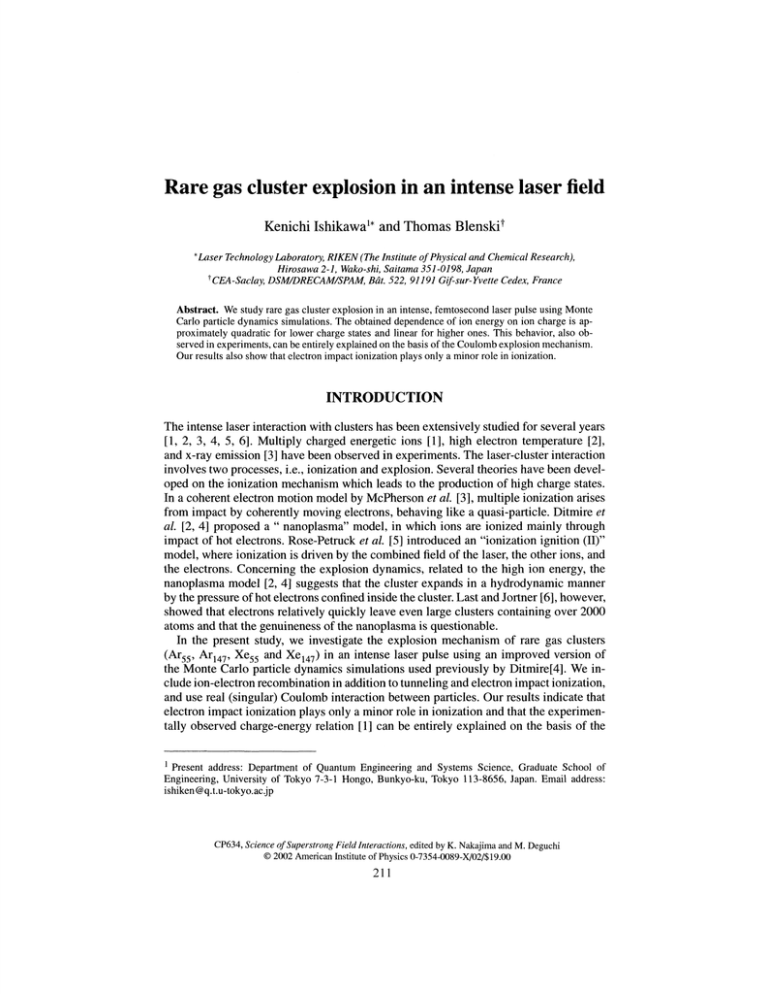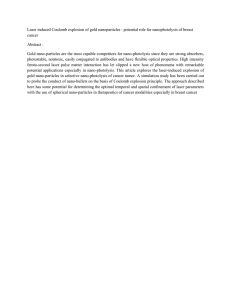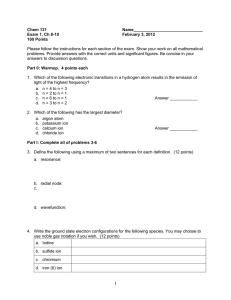Rare gas cluster explosion in an intense laser field Kenichi Ishikawa
advertisement

Rare gas cluster explosion in an intense laser field Kenichi Ishikawa1* and Thomas Blenski1 * Laser Technology Laboratory, RIKEN (The Institute of Physical and Chemical Research), Hirosawa 2-1, Wako-shi, Saitama 351-0198, Japan ^CEA-Saclay, DSM/DRECAM/SPAM, Bat. 522, 91191 Gif-sur-Yvette Cedex, France Abstract. We study rare gas cluster explosion in an intense, femtosecond laser pulse using Monte Carlo particle dynamics simulations. The obtained dependence of ion energy on ion charge is approximately quadratic for lower charge states and linear for higher ones. This behavior, also observed in experiments, can be entirely explained on the basis of the Coulomb explosion mechanism. Our results also show that electron impact ionization plays only a minor role in ionization. INTRODUCTION The intense laser interaction with clusters has been extensively studied for several years [1, 2, 3, 4, 5, 6]. Multiply charged energetic ions [1], high electron temperature [2], and x-ray emission [3] have been observed in experiments. The laser-cluster interaction involves two processes, i.e., ionization and explosion. Several theories have been developed on the ionization mechanism which leads to the production of high charge states. In a coherent electron motion model by McPherson et al. [3], multiple ionization arises from impact by coherently moving electrons, behaving like a quasi-particle. Ditmire et al. [2, 4] proposed a " nanoplasma" model, in which ions are ionized mainly through impact of hot electrons. Rose-Petruck et al. [5] introduced an "ionization ignition (II)" model, where ionization is driven by the combined field of the laser, the other ions, and the electrons. Concerning the explosion dynamics, related to the high ion energy, the nanoplasma model [2, 4] suggests that the cluster expands in a hydrodynamic manner by the pressure of hot electrons confined inside the cluster. Last and Jortner [6], however, showed that electrons relatively quickly leave even large clusters containing over 2000 atoms and that the genuineness of the nanoplasma is questionable. In the present study, we investigate the explosion mechanism of rare gas clusters (Ar55, Ar147, Xe55 and Xe147) in an intense laser pulse using an improved version of the Monte Carlo particle dynamics simulations used previously by Ditmire[4]. We include ion-electron recombination in addition to tunneling and electron impact ionization, and use real (singular) Coulomb interaction between particles. Our results indicate that electron impact ionization plays only a minor role in ionization and that the experimentally observed charge-energy relation [1] can be entirely explained on the basis of the 1 Present address: Department of Quantum Engineering and Systems Science, Graduate School of Engineering, University of Tokyo 7-3-1 Hongo, Bunkyo-ku, Tokyo 113-8656, Japan. Email address: ishiken@q.t.u-tokyo.ac.jp CP634, Science of Super strong Field Inter actions, edited by K. Nakajima and M. Deguchi © 2002 American Institute of Physics 0-7354-0089-X/02/$ 19.00 211 Coulomb explosion mechanism. MODEL Since the simulation model is detailed in Ref. [7], we summarize it only briefly here. The nonrelativistic equation of motion of each ion and electron is integrated using the force calculated as the sum of the contributions from all the other particles and the laser electric field. We model the field from an ion of charge state Q as a real Coulomb one from an effective nuclear charge Qeff (r) of the form, M-f ^f(r>-\ 0 Z(l-r/ra) for r<(Z-Q)ra/Z, Q for r>(Z-Q)ra/Z, (l) with Z being the atomic number and ra the "atomic radius" (1.3 a.u. for Ar and 2.0 a.u. for Xe). This potential is more suitable for the description of ion-electron interaction than a soft Coulomb potential used by Ditmire[4]. To handle an ion-electron close encounter, we resort to Kustaanheimo-Stiefel regularization[8], widely used in astrophysics. Free electrons appear through tunnel ionization or elecron impact ionization (EII). We evaluate the tunneling rate via an analytic formula [9] using the total electric field seen by each ion, and calculate the EII cross section using fitting formulas by Lennon et al. [10] for Ar and the Lotz formula [11] for Xe. Upon ionization a new electron is placed near the ion in such a way that the total energy is conserved. Free electrons may be recombined with ions. A pair of an ion of charge Q and an electron is replaced by an ion of charge Q — 1 if the distance between them is decreasing, if there is no potential barrier between them, and if the total energy of the electron is negative. The pulse used in our simulations has a field envelope proportional to sine squared with a full width at half maximum of 100 fs and a wavelength of 780 nm. The clusters used in our simulations are Ar55, Ar147, Xe55, and Xe147 with a closed-shell icosahedral structure [12] with an atom spacing of 3.76 A for Ar and 4.32 A for Xe [13]. IONIZATION Figure 1 shows the temporal evolution of the mean ion charge state for the case of an Ar147 cluster (solid line) and individual Ar atoms (dashed line) irradiated by a laser pulse with a peak intensity of 1.4 x 1015W/cm2. The mean charge state obtained in a cluster gas is considerably higher than that in an atomic gas. Moreover, high charge states up to 8+ were obtained from the cluster gas though it is not explicitly indicated in the figure. In order to examine the importance of EII, we have performed a simulation with EII switched off, whose result is shown as a dotted line in Fig. 1. It can be seen that EII has practically no effect on the mean charge state. Moreover, the highest charge state produced by EII was only 5-f. This result is easy to understand from the viewpoint of mean free path. The electron mean free path with respect to EII of Ar5+ in an Ar cluster takes the minimum value of 580 A at an incident energy of 300 eV. This is even larger 212 20 40 60 80 100 120 140 160 180 200 Time (fs) FIGURE 1. Evolution of the mean charge state per ion in Ar147 (solid line) and an atomic gas of Ar (dashed line) irradiated by the pulse with a peak intensity of 1.4 x 1015 W/cm2. The dotted line is the result for Ar147 with electron impact ionization switched off. 2 3 4 5 6 7 8 9 101 Mean charge state Q FIGURE 2. Relation between the mean ion energy E and the mean charge state Q obtained using different intensities (starting from the lowest value of Q, 0.35, 1.4, 3.2, 5.6, 8.8, 13 x 1015W/cm2 for Ar5J, Ar147, and Xe55, and 0.35,0.79,1.0, 1.4, 1.9, 3.2, 13, 5.6, 8.8 x 1015W/cm2 for Xe147). The values of E for Xe clusters were multiplied by 1.5 for clarity. than the diameter of Ar 6 (410 A). Thus, the contribution of EII to the production of high charge states is negligible. A similar argument holds true for Xe clusters. On the other hand, once several atoms are ionized, the total electric field strength seen by each ion can be significantly larger than the laser field alone. This leads to high charge states, driving further tunneling ionization, just as in the II model [5]. 213 CHARGE-ENERGY RELATION In Fig. 2 we plot the relation between the mean ion energy E and the mean charge state Q. The relation can be modeled with E w ag2, where a is a constant. This indicates that ions are accelerated mainly through a Coulomb explosion mechanism. In fact, electrons quit the cluster before they exchange significant energy with ions, which excludes a hydrodynamic scenario. A 147-atom cluster consists of a central atom and three closed atomic shells. The outermost and middle shells are composed of three and two subshells, respectively. In Fig. 3 we plot the mean energy ES(Q) of the ions with a charge of Q in subshell s (s = 1, • • • ,6) of Xe147 in the case of a peak intensity 8.8 x 1015W/cm2. We can model the relation with ES(Q) « flsQ, where a constant f}s depends on 5-. In Fig. 3 we have also plotted the average E(Q) ofEs(Q) over the entire cluster as filled circles. Again E(Q) is approximately proportional to Q. We have found that this holds more or less also for Ar55, Ar147, and Xe55 and for other values of laser intensity. We simulated the pure Coulomb explosion of Xe147, neglecting the electronic fields in the ionic equations of motion but taking account of the ion charge history obtained for the case of Fig. 3. The resulting energy-charge relation is very similar to that in Fig. 3. This confirms that the approximately linear dependence is due to the mutual Coulomb repulsion between ions. Lezius et al. [1] found a quadratic charge dependence of ion energy for lower charge states and a linear dependence at higher charge states in their experiments with Xe clusters. If we take a spatial profile of the laser intensity into account, we observe a similar behavior in our simulation results. This is illustrated in Fig. 4, which shows the ion charge-energy relation that we obtained by taking average over the simulation results with different values of intensity as in Fig. 2. It can be seen from Fig. 4 that the relation is quadratic for lower charges and linear for higher charges. This behavior can be entirely explained as a consequence of Coulomb explosion as follows: for lower charges, the contribution to each charge state Q mainly comes from such a spatial region where the 1ft 12 cS !•*} ^ 8 © 0 D 0 A <8> • SubsheUl Subshell 2 SubshellS Subshell 4 SubshellS Subshell 6 Entire cluster x 0.4 j8) < '* • *<§> A .x** .0* A* .•*** .^** .•*' .®* ./5f* ..•** .»**>•' ^'* A*** £••<> V-'* ..•** 1 6 1 4 2 .%'-*;'!''''*!'-*'"..e*"a ^ .->—*""*"""' .^^^-rr;:::^"^"* ; rr : :Tr n ^i^r- = -' ' "" 4 . 6 8 10 Charge state Q 12 14 FIGURE 3. Mean ion kinetic energy E(Q) as a function of charge state Q for each subshell of Xe147 and for the entire cluster (filled circles, multiplied by 0.4 for clarity.) in the case of a peak intensity 8.8 x 1015W/cm . The subshells are enumerated outwards starting from the innermost one. 214 fk.O f * M47 A Ar55 c§,3.5 (a) ^3.0 X ^*»* •** y* bO § 2.5 CD OH 2.0 •^ |l.5 | ..•A'* .X.x^ L0 ^ 0.5 nn r 0 ^•"'A' •••;.'.*•""*'. . . . . . ...Ait*****" 1 2 3 4 5 6 7 Charge state ^ 8 6 8 10 Charge state Q 12 9 1 0 >8 ^7 &T 6B6 V 14 FIGURE 4. Charge dependence of ion energy of (a) Ar55, Ar147 and (b) Xe55, Xe147 irradiated by the laser pulse with a peak intensity of 1 .3 x 1016W/cm2, with account of the spatial intensity profile. mean charge state equals to Q. As a result, we obtain a quadratic relation, corresponding to the one in Fig. 2. On the other hand, ions of higher charges come from the same region where the intensity is highest. This leads to a linear relation, corresponding to the one in Fig. 3. In Ref. [1] the relation was reported to be quadratic in the entire range of 1 < Q < 8 in the case of Ar. This is probably because the authors of Ref. [1] used sufficiently high intensity (5 x 1017W/cm2) to produce Ar8+ while the yield of Ar^+ (Q > 9), for which a linear relation should be expected, was very low since the ionization potential of Ar8+ (422 eV [14]) is much higher than that of Ar7+ (143 eV [14]). The preceding discussion has an important impact on the interpretation of the experimental results by Lezius etal. [1]. These authors interpreted the linear relation found for higher charge states as a sign of hydrodynamic expansion. Our results, however, indicate that this is not necessarily correct. 215 CONCLUSIONS We have studied the explosion of rare gas clusters containing up to 147 atoms in an intense laser field via Monte Carlo particle dynamics simulations. Electron impact ionization plays only a minor role in ionization. The entire charge dependence of ion kinetic energy, including a linear part at higher charge states, formerly attributed to hydrodynamic expansion, can be understood on the basis of Coulomb explosion. It is true that our simulation results cannot directly exclude the possibility of hydrodynamic expansion in larger clusters containing over 1000 atoms. However, it is striking that the overall feature of the charge-energy relation in Fig. 4 is similar to the one obtained by Lezius et al. [1] Last and Jortner [6] showed that electrons quickly leave even large clusters containing 2097 atoms. Moreover, according to our results, the mean energy of ions is 10-20% higher when they are emitted along the direction of laser polarization than perpendicular to it, which agrees with a recent experimental finding [15]. These agreements strongly indicate that the cluster explosion may be essentially governed by Coulomb explosion also in large clusters. REFERENCES 1. 2. 3. 4. 5. 6. 7. 8. 9. 10. 11. 12. 13. 14. 15. Lezius, M., Dobosz, S., Normand, D., and Schmidt, M., Phys. Rev. Lett., 80, 261-264 (1998). Ditmire, T., Donnelly, T., Rubenchik, A. M., Falcone, R. W., and Perry, M. D., Phys. Rev. A, 53, 3379-3402(1996). Thompson, B. D., McPherson, A., Boyer, K., and Rhodes, C. K., J. Phys. B, 27,4391-4400 (1994). Ditmire, T., Phys. Rev. A, 57, R4094-R4097 (1998). Rose-Petruck, C., Schafer, K. J., Wilson, K. R., and Barty, C. P. J., Phys. Rev. A, 55, 1182-1190 (1997). Last, I., and Jortner, J., Phys. Rev. A, 60, 2215-2221 (1999). Ishikawa, K., and Blenski, T., Phys. Rev. A, 62, 063204 (2000). Aarseth, S. J., "Direct Methods for Af-Body Simulations," in Multiple Time Scales, edited by J. U. Brackbill and B. I. Cohen, Academic Press, Orlando, 1985, pp. 377-418. Perelomov, A. M., Popov, V. S., and Terent'ev, M. V., Sov. Phys. JETP, 23, 924-934 (1966). Lennon, M. A., Bell, K. L., Gilbody, H. B., Hughes, J. G., Kingston, A. E., Murray, M. J., and Smith, F. J., /. Phys. Chem. Ref. Data, 17, 1285-1363 (1988). Lotz, W., Z. Phys., 216, 241-247 (1968). Northby, J. A., J. Chem. Phys., 87, 6166-6177 (1987). Bondi, A., J. Phys. Chem., 68, 441-451 (1964). Cowan, R. D., the Theory of Atomic Structure and Spectra, Univ. of California Press, Berkeley, 1981. Springate, E., Hay, N., Tisch, J. W. G., Mason, M. B., Ditmire, T., Hutchinson, M. H. R., and Marangos, J. P., Phys. Rev. A, 61,063201 (2000). 216




